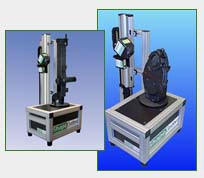Medical device components, such as implants and prosthetics, pose a number of challenges for manufacturers. In addition to being highly complex, they need to be extremely reliable for use in human patients. Moreover, some medical devices are custom “one-of-a-kind” parts with very specific measurements for an individual patient.

Components like this knee implant, made by DePuy Orthopaedics (shown implanted inside the human body in the X-ray), are checked with laser scanning, because of the complex sculptured contours required for proper functioning.
Automated 3D scanners like those from ShapeGrabber help companies to quickly measure complex-shaped medical parts, including parts with compound curves. Unlike traditional methods (like calipers or coordinate measuring machines) that rely on the capture of a few pre-programmed points, a non-contact 3D laser scanner captures millions of data points to represent the true geometry of an existing component.
A 3D scanner captures a dense “point cloud” that represents the complete surface area of the part. This data can be used with software for measurement, and direct comparison to the CAD model. Using a 3D scanner, manufacturers of medical components can:
- Reduce inspection time
- Ensure that 100% of dimensional specifications are met
- Troubleshoot fit problems between parts
- Automate the inspection process
- Provide documented proof that they are meeting specifications

DePuy uses a ShapeGrabber Automated 3D scanner like the one pictured above.
As a mature technology (at ShapeGrabber, we’ve been pioneering industrial 3D scanners for more than 20 years), 3D laser scanning is ideal for medical device manufacturers for the following reasons:
- It’s fast. Lasers can capture millions of data points in minutes. The complete surface geometry of an entire part can be captured quickly.
- It handles complex shapes. Curves and multiple features aren’t a problem for
industrial 3D laser scanners. They easily scan the complex surface dimensions
of parts and tools that would otherwise be too time-consuming, costly or simply
impossible to measure. - It’s easy. You don’t need to write a computer program before scanning a part.
- It saves time & money. A 3D scanner saves hours or days of inspection/measurement tasks and results in better-performing parts.
To learn more, we recommend these
resources:
